In my previous installment of Witchy Wednesday about Baba Yaga, I talked about how surprised I was in realizing she’s featured in a number of different animated films of my youth, including a few by Studio Ghibli. This got me thinking about all of the other witches I’ve come to know and love (or hate), mostly including those from my favorite Disney movies growing up.
Most people know that a majority of Disney films, at least the classics, are based off of popular fairy tales by such names as The Brothers Grimm, Hans Christian Andersen, and so on. I think fewer people know exactly how different these kid-friendly movies are from the originals, though — especially when it comes to the villains, particularly of the witch variety.
Maleficent, Sleeping Beauty
Also known as Little Briar Rose in German, the Sleeping Beauty I grew up knowing was a beautiful young woman cursed as a baby by a wicked witch, hidden away in the forest so as to hopefully never face her cursed destiny of “falling into a sleep like death,” upon her 16th birthday. Naturally, all of this is foiled when she stumbles into the handsome prince, allowing the witch to find and capture her.
Although to be specific, the story of Sleeping Beauty technically originates from Charles Perrault in 1696 (titled The Sleeping Beauty in the Wood), and then Giambattista Basile in 1634 (titled Sun, Moon, and Talia), it wasn’t until The Brothers Grimm came along in 1812 that the story became more popular, later to be reconceptualized in the Disney movie.
The Grimms’ story begins similarly to the Disney tale, though the queen is told of her desired pregnancy through the mouth of a frog:
What the frog said did happen, and the queen gave birth to a girl who was so beautiful that the king could not contain himself for joy, and he ordered a great celebration. He invited not only his relatives, friends, and acquaintances, but also the wise women so that they would be kindly disposed toward the child. There were thirteen of them in his kingdom, but because he had only twelve golden plates from which they were to eat, one of them had to remain at home.
The feast was celebrated with great splendor, and at its conclusion the wise women presented the child with their magic gifts. The one gave her virtue, the second one beauty, the third one wealth, and so on with everything that one could wish for on earth.
The eleventh one had just pronounced her blessing when the thirteenth one suddenly walked in. She wanted to avenge herself for not having been invited, and without greeting anyone or even looking at them she cried out with a loud voice, “In the princess’s fifteenth year she shall prick herself with a spindle and fall over dead.” And without saying another word she turned around and left the hall.
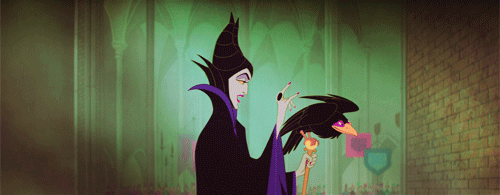
Everyone was horrified, and the twelfth wise woman, who had not yet offered her wish, stepped forward. Because she was unable to undo the wicked wish, but only to soften it, she said, “It shall not be her death. The princess will only fall into a hundred-year deep sleep.”
The king, wanting to rescue his dear child, issued an order that all spindles in the entire kingdom should be burned. The wise women’s gifts were all fulfilled on the girl, for she was so beautiful, well behaved, friendly, and intelligent that everyone who saw her had to love her.
Source: Pitt.edu
While Basile’s original story ends slightly less romantically, The Grimms’ tale concludes similarly to the Disney story, with a kiss from the prince which awakens the princess, and they live happily ever after.
Not all adaptations follow the source material so closely, however …
Mother Gothel, Tangled / Dame Gothel, Rapunzel
The first story of Rapunzel was written by Friedrich Schulz in 1790, and then rewritten and published again by the Grimm Brothers in 1812, in their collection of fairy tales titled Children’s and Household Tales.
In the Disney version, renamed Tangled and released in 2010, Rapunzel retains her gloriously long locks of hair, of which Gothel uses to climb into the tower where she’s kept in secret. Any fan of the film knows this is where the plot takes on a life of its own, however, when Flynn Rider, her handsome rescuer, is anything but a prince. Handsome, maybe, but certainly not royalty.

In Grimms’ tale, Dame Gothel is a wicked old witch who lives in a house alongside a couple, whose garden overflows with beautiful, delicious vegetables — including rapunzel, a type of lettuce also known as rampion. After the husband breaks into the witch’s garden for a sample of the lettuce, which his wife craves “to the point of death,” Gothel discovers him. Desperate to escape with his life, the witch makes a deal: he’s welcome to all of the rapunzel he wants, so long as he gives her their first born child in exchange.
Then the enchantress allowed her anger to be softened, and said to him, “If the case be as you say, I will allow you to take away with you as much rampion as you will, only I make one condition, you must give me the child which your wife will bring into the world. It shall be well treated, and I will care for it like a mother.”
The man in his terror consented to everything, and when the woman was brought to bed, the enchantress appeared at once, gave the child the name of Rapunzel, and took it away with her.
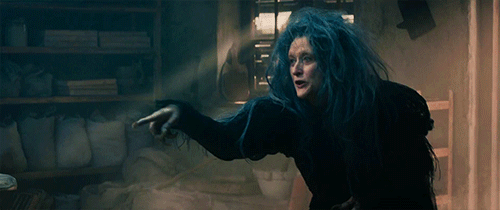
Rapunzel grew into the most beautiful child under the sun. When she was twelve years old, the enchantress shut her into a tower, which lay in a forest, and had neither stairs nor door, but quite at the top was a little window. When the enchantress wanted to go in, she placed herself beneath it and cried,
“Rapunzel, Rapunzel, let down your hair!”
Source: German Stories
In Tangled, Flynn rescues Rapunzel, and together they defeat Mother Gothel. In the Grimm version of the story, there are two possible endings:
In the first edition, as the prince comes nightly to avoid Gothel’s suspicion, Rapunzel later mentions something along the lines of her dress “fitting more snugly,” implying pregnancy.
In the second, and more circulated edition, Rapunzel lets slip the words, “Tell me, Dame Gothel, how it happens that you are so much heavier for me to draw up than the young king’s son — he is with me in a moment.”
“Ah! You wicked child,” cried the enchantress. “What do I hear you say. I thought I had separated you from all the world, and yet you have deceived me.”
In her anger she clutched Rapunzel’s beautiful tresses, wrapped them twice round her left hand, seized a pair of scissors with the right, and snip, snap, they were cut off, and the lovely braids lay on the ground. And she was so pitiless that she took poor Rapunzel into a desert where she had to live in great grief and misery.
On the same day that she cast out Rapunzel, however, the enchantress fastened the braids of hair, which she had cut off, to the hook of the window, and when the king’s son came and cried,
“Rapunzel, Rapunzel, let down your hair!” She let the hair down. The king’s son ascended, but instead of finding his dearest Rapunzel, he found the enchantress, who gazed at him with wicked and venomous looks.
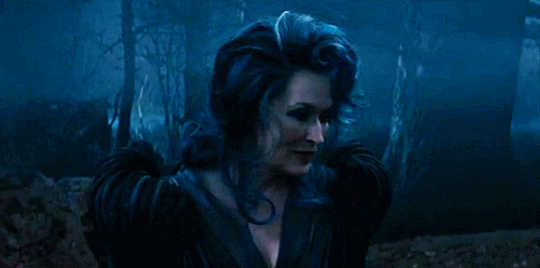
Overcome with distress, the prince flings himself from the tower window, falling to the bottom into a thorn bush, which blind him. In the end, after wandering blindly between the trees for years, he stumbles upon his dear Rapunzel again after hearing her familiar singing voice. Living “in wretchedness,” she is with his children, twins, a boy and a girl. After being found, Rapunzel falls upon him and weeps tears of happiness, which fall into the prince’s eyes and cure him of his blindness. After which, they return to the kingdom, and live happily ever after.
The Queen, Snow White/Snow White and the Seven Dwarfs
Known as only Snow White in the 1854 Grimm collections, and the longer Snow White and the Seven Dwarfs in the 1937 Disney version, both stories follow the same path, up until the finale.
A beloved king loses his beautiful young queen and then remarries an evil, vindictive queen, who pines for nothing more than to be the most beautiful in all the kingdom. But, when her young stepdaughter comes of age and threatens to overtake her in that regard, the queen becomes set on disposing of her.
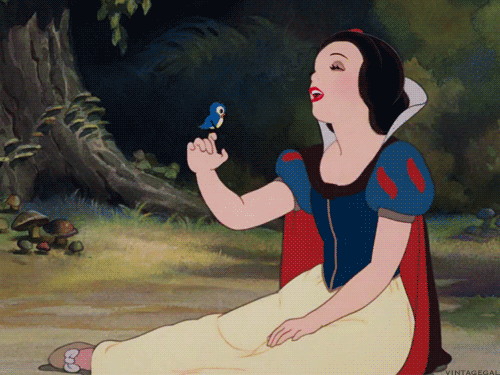
Hiring a huntsman to take her into the forest, the Queen tells him to kill and remove Snow White’s heart (in the Grimm version, that being her lungs and liver) — but the huntsman can’t bring himself to finish it and instead sets Snow White free, taking the heart of an animal to the Queen and claiming it to belong to Snow White.
Then she summoned a huntsman and said to him, “Take Snow-White out into the woods. I never want to see her again. Kill her, and as proof that she is dead bring her lungs and her liver back to me.”
The huntsman obeyed and took Snow-White into the woods. He took out his hunting knife and was about to stab it into her innocent heart when she began to cry, saying, “Oh, dear huntsman, let me live. I will run into the wild woods and never come back.”
Because she was so beautiful the huntsman took pity on her, and he said, “Run away, you poor child.”
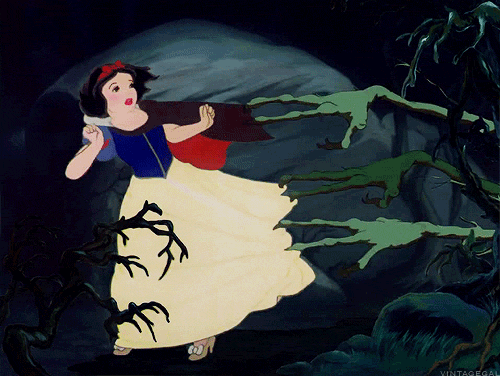
He thought, “The wild animals will soon devour you anyway,” but still it was as if a stone had fallen from his heart, for he would not have to kill her.
Just then a young boar came running by. He killed it, cut out its lungs and liver, and took them back to the queen as proof of Snow-White’s death. The cook had to boil them with salt, and the wicked woman ate them, supposing that she had eaten Snow-White’s lungs and liver.
Source: Pitt.edu
After fleeing, she finds the seven dwarfs, and many songs are sung. The queen later implores the mirror again, expecting it to finally inform her that she’ll be the fairest of all for the rest of her life — only to be shocked when he tells her Snow White is still alive. Plotting once and for all to kill her stepdaughter, she dons the face of an old crone and offers her a poisoned apple, which causes Snow White to fall into a deep sleep, which can only be broken by “true love’s first kiss.”
“Are you afraid of poison?” asked the old woman. “Look, I’ll cut the apple in two. You eat the red half, and I shall eat the white half.”
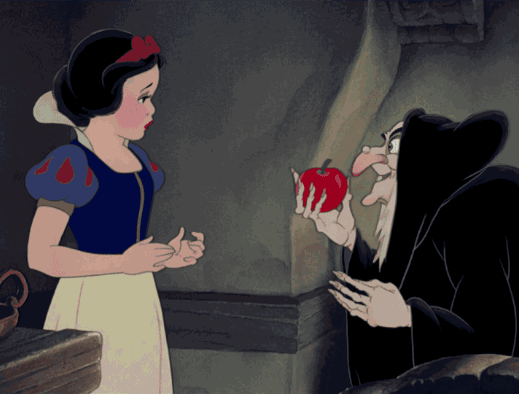
Now the apple had been so artfully made that only the red half was poisoned. Snow-White longed for the beautiful apple, and when she saw that the peasant woman was eating part of it she could no longer resist, and she stuck her hand out and took the poisoned half. She barely had a bite in her mouth when she fell to the ground dead.
The queen looked at her with a gruesome stare, laughed loudly, and said, “White as snow, red as blood, black as ebony wood! This time the dwarfs cannot awaken you.”
Back at home she asked her mirror:
Mirror, mirror, on the wall,
Who in this land is fairest of all?
It finally answered:
You, my queen, are fairest of all.
Then her envious heart was at rest, as well as an envious heart can be at rest.
This is the point that the Disney film deviates from the original — in the Disney story, the dwarfs and woodland animals return to find Snow White unconscious in their home, and after realizing the old crone is to blame, give chase, eventually causing her to flee over the side of a cliff and fall to her death.
In the Grimm Brothers’ tale, the witch returns to the castle, believing she was finally victorious. Unbeknownst to her, however, a prince stumbles upon Snow White’s clear casket, and so taken with her beauty, pleads with the dwarfs to allow him to take it back to his castle. Upon jarring the coffin, the bite of poison apple falls from Snow White’s mouth, and she awakens, as opposed to the life-saving kiss laid upon her in the Disney version.
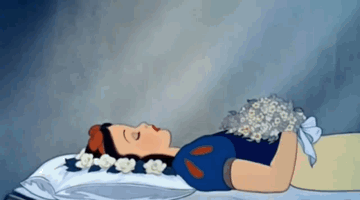
The prince returns to his kingdom with Snow White in tow, and they plan a celebration. The queen is invited, and after dressing herself, approaches the mirror one last time to ask…
Mirror, mirror, on the wall,
Who in this land is fairest of all?
The mirror answered:
You, my queen, are fair; it is true.
But the young queen is a thousand times fairer than you.
The wicked woman uttered a curse, and she became so frightened, so frightened, that she did not know what to do. At first she did not want to go to the wedding, but she found no peace. She had to go and see the young queen. When she arrived she recognized Snow-White, and terrorized, she could only stand there without moving.
Then they put a pair of iron shoes into burning coals. They were brought forth with tongs and placed before her. She was forced to step into the red-hot shoes and dance until she fell down dead.
All in all, what a way to go.
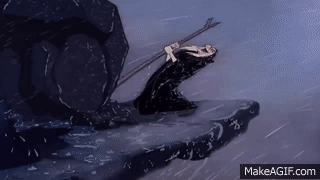
All of these movies, I watched on the floor of my grandparents’ house. They’re the movies my mom would let me watch on long drives before I got too carsick, movies that probably lead to my obsession with all things animation, cartoon, and magic as a grown-up. There’s probably good reason for the change of the more morbid details in the Disney movies, otherwise I can’t imagine what else I might’ve turned into. Rather than dressing in princess gowns and fluttery outfits, I might’ve chosen the black capes and horns way earlier in my childhood. Not that I’m complaining, that would’ve been cool.
What other fairy tales have gruesome origins not shown in the kid-friendly animated movies of our youth? Were there any you were shocked to discover, whether on this list or not? Post them in the comments!
Honorable Mention: The Shadow Man, The Princess and the Frog/The Frog Prince
As it turns out, in the original version of The Frog Prince, there isn’t much of a villain at all, except when the frog, since turned into a prince, mentions in passing the witch/fairy (depending on which version) who cast a spell on him.
You can imagine my disappointment when I wasn’t able to delve deeper into Disney’s The Shadow Man, also known as Dr. Facilier. I did, however, come across an animated short film based on the original Grimm version of the story, and witnessed the greatest moment ever to be shown on film:
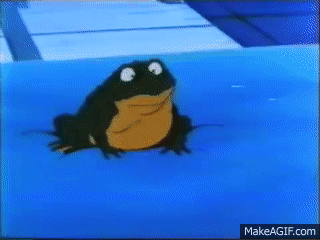
Source: Youtube
Kelsey graduated from Boise State University with a BA in Visual Arts, and is currently working as a freelance writer, while doodling anime on the side with one hand and petting cats with the other.

You know, I’m so glad you wrote this. Ever since your Baba Yaga post, I’ve been thinking about all the Disney witches she may have inspired. Love how you did the Grimm version compared to the Disney interpretation too. Another fantastic post!